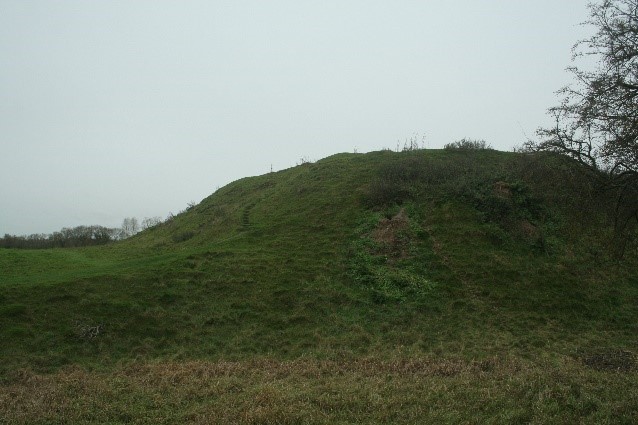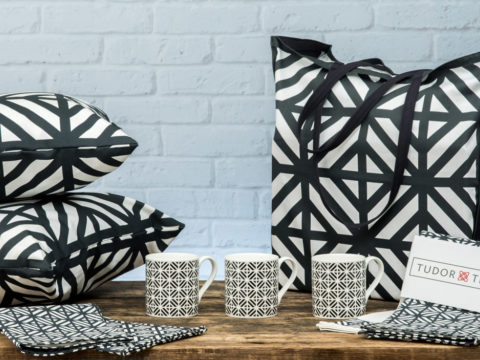Fotheringhay Castle & Church
Chapter 2 : The Castle
The track leading to the castle is situated on a sharp bend on the road, heading south-west out of the village. There is also a footpath, directly to the left of Castle Farm.
The village dates from before the Norman Conquest when the manor was held by the Earl of Huntingdon. It was granted to William the Conqueror’s niece, Countess Judith of Lens, on her marriage to Earl Waltheof of Huntingdon, one of the few Anglo-Saxon earls to find a place in the post-Conquest hierarchy.
The couple had three daughters, the second of whom, Maud, inherited the manor and married Simon of Senlis. Simon built the castle around about 1100. On his death Maud remarried, to David I, King of Scots, and the manor descended in the Scottish Royal family until 1294 when it Edward I confiscated it in the lead-up to the Wars of Scottish Independence. At some point, according to the information in Fotheringhay Church, the Castle came into the possession of Marie of Valence, Countess of Pembroke (c. 1303-1377). She lived at Fotheringhay for some time and was much admired for her charitable and pious life. She was the founder of Pembroke College, Cambridge.
During Marie’s tenure the castle is described thus:
‘…with the central tower, [it] is built of stone, walled in, battlemented and encompassed with a good moat. Within are one large hall, two chambers, two chapels, a kitchen and a bakehouse, built all of stone, with a porter’s lodge and chambers over it and a drawbridge beneath. Within the castle walls is another place called the Manor, in which are houses and offices and an outer gate with a room over it. The site of the whole contains two acres.’
In 1377, the castle was granted by Edward III to his fourth son, Edmund of Langley, Earl of Cambridge and then Duke of York. Edmund, who was appointed as Keeper of the Realm for Richard II on the latter’s absence in Ireland, was in charge of raising a force to repel Henry Bolingbroke’s invasion in 1399. Despite his initial support for Richard II, Edmund decided to throw in his lot with his other nephew, Henry, who took the throne as Henry IV, first king of the House of Lancaster.
Edmund substantially improved the castle, before dying in 1402. His eldest son, Edward, inherited his lands and title. Just prior to embarking for France in the train of his cousin, Henry V, a conspiracy was discovered, led by Edward’s brother, Richard, Earl of Cambridge. The purpose of the conspiracy was to put Richard’s brother-in-law, Edmund Mortimer, on the throne as the descendant (although in the maternal line) of Edward III’s second son, Lionel of Clarence, rather than the third son, from whom Henry V was descended. Cambridge and his fellow conspirators were tried and executed.
Despite Edward disowning his younger brother, Henry V’s suspicions were aroused against him. Nevertheless, he continued as part of the French invasion force and died at the battle of Agincourt. Edward’s body was boiled, to remove the flesh and enable the return of his bones to England.
With Richard of Cambridge dead, Edward’s titles and land passed to his nephew, Richard, now 3 rd Duke of York. Richard and his wife, Cicely Neville, daughter of Ralph Earl of Westmorland, used Fotheringhay Castle as their main seat, although as the heir not only of Edward of York, but also of his Mortimer uncles, Richard was the wealthiest noble in England with land stretching across the country, including a large holding in the Welsh Marches, centred on Ludlow Castle. Duchess Cicely spent a good deal of time at Fotheringhay when they were in England, although Richard’s roles as Lieutenant in Normandy and later in Ireland meant that the family often travelled. However, Cicely’s youngest son, later Richard III, and daughter, Margaret, later Duchess of Burgundy, were born at Fotheringhay.
The Duke of York’s strong claim to the throne was at the heart of the dynastic struggle known as the Wars of the Roses. York was killed at the Battle of Wakefield in 1463, together with his second son Edmund, Earl of Rutland. Their bodies were buried by the Lancastrians at the Castle of Pontefract in Yorkshire, with the men’s heads being placed on spikes on Micklegate Bar, overlooking the city of York. This was felt to be extremely disrespectful to a senior noble and did not endear Queen Marguerite of Anjou (wife of Henry VI, and prime mover behind the Lancastrian cause) to the Yorkists.
Following the victory of Henry VII at Bosworth Field where Richard III was killed, Fotheringhay Castle became part of Crown lands and was granted to Elizabeth of York – as eldest surviving child of Edward IV, she had a strong claim to it as her own inheritance. There are records of the castle being used in 1506, by Henry’s mother, Lady Margaret Beaufort, Countess of Richmond and Derby, who had been born not far away at Bletsoe, in Bedfordshire. Lady Margaret had lodgings assigned for at least 39 servants while she was in residence.
It became part of the jointure of all Henry VIII’s queens, although none of them seem to have used it and it was similarly ignored by Edward VI, Mary I, and Elizabeth I, other than a short visit by her 1573.
During 1586 the castle became the final prison of Mary, Queen of Scots. She was moved there from Chartley in Staffordshire, following the discovery of the Babington plot. It was here that the Queen was tried late in 1586, and executed on 8 February 1587. A large platform was built as a scaffold within the Great Hall where the execution took place. Following her death, her clothes, her prayer book and everything associated with the beheading was burnt lest any relics be kept. The Queen herself was interred first at Peterborough Cathedral, and then, eventually, in Westminster Abbey.
By 1592, the castle was used for militia stores, before being granted in 1603 to Lord Mountjoy, Lieutenant of Ireland, and lover of Lady Penelope Devereux. The castle fell into disrepair after 1623, and all that is left now is the old motte and traces of the bailey, with a small fragment of stonework from the encircling walls. Standing at the top of the mound there is a good view over the very flat Northamptonshire countryside with the River Nene meandering through.







